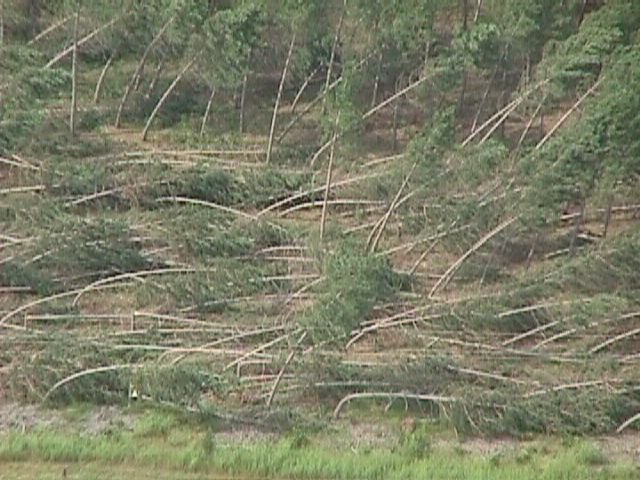Wind
The strong winds of a microburst blew these trees down. Notice how they are all blown in the same direction.
Credit: NOAA
Wind is air moving from a place that has higher pressure to one that has lower pressure.
Let’s say that you blow up a balloon but don’t tie a knot at the open end. You just pinch it closed with your fingers. Then, you relax your fingers a little and let some air flow out of the balloon. Have you ever thought about why the air comes out of the balloon instead of going in?
Air comes out because the pressure inside the balloon is higher than the pressure outside the balloon. Air molecules will spread out, spacing themselves far apart if they have the room. Air pressure isn’t exactly the same everywhere at the Earth’s surface because the Sun heats some places more than others. In the places where air is warmed most, it rises. This leaves a little less air near the Earth’s surface than in surrounding areas that didn’t get as warm. There is still air everywhere, but the air molecules are more widely spaced in some areas and more tightly packed in others. The places with more air molecules have higher pressure. The areas with fewer air molecules have lower pressure. Air whooshes into the area with lower pressure. That’s wind. So when you let the air out of a balloon, you are making a little bit of wind.
Wind Strength
Sometimes wind is just a light breeze and other times it is strong enough to blow the roofs off buildings. To describe the strength of wind, weather reports often use words like Light Wind, Strong Wind, and Gale. The Beaufort Scale assigns a number between zero and twelve to describe the strength of wind. Zero of the Beaufort Scale is complete calm. Twelve describes the powerful winds found in hurricanes. Winds are also often described according to the direction from which they blow -- easterly winds blow from the east towards the west, while westerly winds blow from the west towards the east.
Global Wind Patterns
There are steady winds that always blow in the same direction because of the pattern of how air moves through the atmosphere over the entire planet. For centuries sailors have depended on these predictable winds known as the Trade Winds, Westerlies, and Polar Easterlies. These winds turn to the right in the Northern Hemisphere and to the left in the Southern Hemisphere because of Earth’s spin, a phenomenon known as the Coriolis Effect.
Specialized Wind Types
Sometimes wind is very strong but lasts only a short time. For example, thunderstorms can create high winds including microbursts and tornadoes. While the wind from a microburst flows down and away from a thunderstorm, wind from a tornado flows up and into a thunderstorm. Monitoring tools such as Doppler radar and the Low-Level Windshear Alert System are used to spot microbursts and tornadoes.
- Microbursts form when air, cooled rapidly within a storm, zooms downward at high speeds because it is more dense than the surrounding air. When it gets to the ground it spreads across the Earth’s surface as straight-line winds moving at speeds over 100 miles per hour. They only last a few minutes but can be deadly.
- Tornadoes form when there is a difference in air pressure between the center of the tornado and its outer edge. The center has very low pressure and the outer edge has very high pressure, creating winds that can blow at over 200 miles per hour. Exactly what causes tornadoes to form is a topic of ongoing research. NCAR’s VORTEX2 field project has been chasing twisters to figure out how they form.
